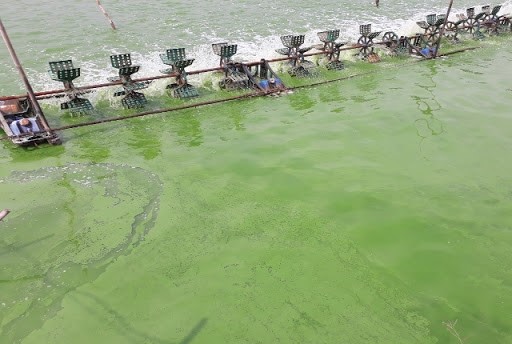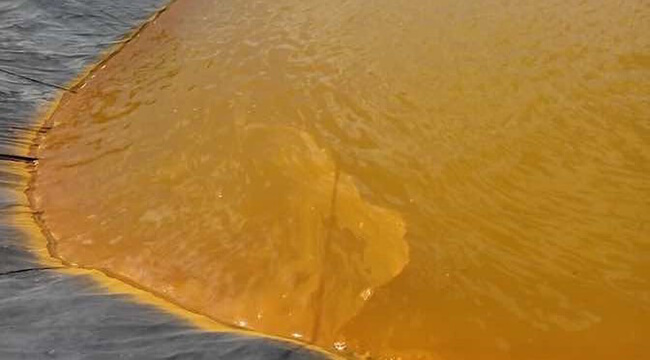1. What should we do when pH is high?
When pH is higher than 8.5, shrimp reduce eating and increase NH3 concentration, which is toxic to shrimp.
– Causes: High dissolved oxygen (DO) concentrations and algae density in ponds; environmental factors in ponds and prolonged hot weather
– Recommendations:
- Changing water when algae density is too high.
- Using probiotics and molasses to stabilize algae density.
- Intensifying paddle wheels and aerations to improve the growth of probiotics.
- If pH is greater than 9, use organic acids to reduce pH immediately.
- Using Yucca with a dose of 1 liter per 2000 cubic meters to limit toxic gases like NH3.

2. What should we do when pH is low?
When pH is lower than 7.5, shrimp reduce their ability to absorb nutrients and minerals. Its shell softens or molts incompletely. It also increases H2S concentration, which is toxic to shrimp.
– Causes: High dissolved oxygen (DO) concentrations and algae density in ponds; environmental factors in ponds, prolonged hot and stormy weather.
– Recommendations:
- Intensifying paddle wheels and aeration to create dissolved oxygen in the water.
- Using probiotics to create watercolor and stabilize the water environment.
- Using CaO with a dose from 5-10 kg per 1000 cubic meters at 2-4 am.
- Using CaCO3, CaO, and minerals after heavy rain.
- Using EDTA with a dose of 2 kg per 1000 cubic meters if the pond is contaminated with alum.
- Using Yucca with a dose of 1 liter per 2000 cubic meters, limiting toxic gases like H2S.
3. What should we do when the alkalinity is high?
When alkalinity is higher than 200 mg CaCO3 per liter, preventing the molting process and shell calcification of the farmed shrimp. It slows the molting of shrimp, leading to slow growth and unequal size.
– Causes: due to heavy metal content, hardness, and acidity being high in ponds or using the groundwater.
– Recommendations:
- Changing water and using EDTA with a dose of 2 kg per 1000 cubic meters for 2 days continuously, periodically 5 days per time if groundwater is used.
- Using the gypsum (CaSO4-CaSO4.2H2O) from 4-5 ppm to soften the water.
- Supplementing mineral with a dose of 2-5 kg per 1000 cubic meters to stimulate the molting shrimp and create a new shell.

4.What should we do when the alkalinity is low?
Alkalinity is lower than 100 mg CaCO3 per liter, which affects the molting process of shrimp, leading to soft shells, body curl, and muscle muddy. In addition, it also slows growth and has a low survival rate. Ponds with low alkalinity (below 50 mg CaCO3 per liter) are difficult to create watercolor.
Causes: Snails and bivalve mollusks compete for alkalinity with shrimp in ponds, low salinity, and inappropriate stocking density.
– Recommendations:
- Killing snails and bivalve mollusks at the beginning of the crop.
- The stocking density is appropriate; salinity is higher than 5 ppt.
- Using Dolomite lime and CaCO3 with a dose of 10 kg per 1000 cubic meters and Bicarbonate with an amount of 2 kg per 1000 cubic meters periodically two days per time to increase alkalinity.
- Using micronutrients to stimulate shrimp shells to harden quickly.
5. What should we do to reduce the loss when transferring shrimp?
Causes: Environmental factors between ponds and nursery ponds are high differences, time to transfer shrimp, lack of minerals, and poor shrimp health.
– Recommendations:
- Checking and adjusting the environmental factors of ponds and nursery ponds appropriately.
- Transferring shrimp in the early morning or late afternoon.
- Supplementing fully mineral to harden the shrimp shell completely.
- Transfering shrimp when the shrimp’s health is good.
6. What should we do when farming shrimp in the rainy season?
Causes: Prolonged storm, fluctuating environmental factors, poor shrimp health, low temperature, and susceptibility to infection when cultured at high density.
– Recommendations:
- Frequently check water environmental factors.
- Periodically supplement minerals, lime, and bicarbonate.
- Regularly check shrimp health.
- Periodically use lime to raise the temperature and stabilize pH.
- Mixing vitamin C, digestive enzymes, minerals, beta-glucan, and sorbitol into the feed to strengthen resistance.
- Stocking with low density.
- Strengthening the microflora of the bottom to decompose waste and inhibit harmful bacteria.
7. What should we do to improve the survival rate for an extensive shrimp farming model?
Causes: high nursing density, poor renovation of nursery ponds and care conditions.
– Recommendations:
- The density of the nursery pond should be 10 shrimps/m2.
- Farming density from 20-30 shrimps/m2 with supplementing paddle wheels.
- Renovating the nursery ponds and farming conditions similar to industrial ponds.
8. Methods to overcome the situation of shrimp falling to the pond bottom after molting
Poor nutrition in ponds leads to an imbalance of nutrient content in shrimp bodies, lack of oxygen, toxic gas like NO2 is high, using groundwater, and shrimp is infected.
– Recommendations:
- Supplementing minerals and amino acids to optimize the nutritional content of the shrimp body and stabilize the buffer system.
- Enhancing dissolved oxygen.
- Using EDTA to remove alum.
- Changing water to release toxic gas like NO2.
- Strengthening the beneficial microflora to inhibit harmful bacteria.
- Siphoning the pond bottom (if any).
9. Methods to overcome the phenomenon of dead algae
Algae always exist in pond water. There are two types of algae in the aquatic environment, including beneficial and harmful algae. The former does not contain toxins. They rarely bloom when growing a lot in the pond, such as green algae and diatoms. In contrast, the latter bloom when dominant in the pond. In addition, it also makes water slimy and foamy and produces many toxins such as Cyanobacteria (tảo lam), Pyrrophyta (tảo giáp), and Euglenophyta (tảo mắt).
– Causes: The microflora of the bottom does not develop well. The waste in the pond does not decompose, causing excess nutrients in the pond water. It leads to algae overgrowth in a short time. Also, it creates an opportunity for toxic algae to grow.
– Recommendations:
- Enhancing the microflora of the pond bottom.
- Increasing bottom oxygen for the microflora to decompose waste.
- Supplementing bicarbonate, dolomite lime, and CaCO3 to create watercolor and stabilize the buffer system.
- Adding lime dolomite and minerals periodically 3 days per time to stabilize watercolor.

10. Methods to overcome the ponds contaminated with alum
Causes: The bottom of shrimp ponds often contains high sulfate content. The combination of anaerobic conditions and microbial activity reduces ones. Therefore, the sulfur (S) will combine with iron (Fe) to FeS2. Low pH increases toxic gas like H2S and seriously affects the shelling process of shrimp. In addition, it also makes shrimp softshells, incomplete molting, and reduces survival rate.
Recommendation:
- Renovating ponds and limiting exposure to oxygen causes red alum precipitation.
- Avoiding the sediment layer when digging ponds.
- Supplementing CaO, dolomite lime, CaCO3, EDTA, or probiotics to remove alum.
- Creating watercolor before stocking shrimp.
* Tips when farming Binh Minh domesticated black tiger shrimp
- Fully supplementing mineral due to the rapid molting cycle of shrimp.
- Providing feed, minerals, nutrients, and resistance for shrimp.
- Supplying adequate oxygen according to each stage of the culture
- Environmental factors must be stable.
- Stocking density should be appropriate according to each model.=> These tips will help shrimp reach a size of 5-6 shrimps/kg.

By Master Huynh Duy Phong – Binh Minh Aquaculture Development Co., Ltd
DOMESTICATED SHRIMP POSTLARVAE – THE KEY TO SUCCESS
See more:
- Insights into omega-3s in aquafeeds
- Can dietary inclusion of montmorillonite clay help mitigate the farmed shrimp AHPND pandemic?
- Bioremediation For Profitable Vannamei Shrimp Farming

 Tiếng Việt
Tiếng Việt 中文 (中国)
中文 (中国)